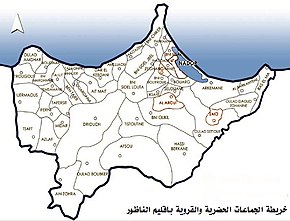Nador (province)



The Moroccan province of Nador, which is around 3100 km² and has a population of around 580,000 ( Arabic إقليم النّاظور, Central Atlas Tamazight ⵜⴰⵙⴳⴰ ⵏ ⵏⵏⴰⴹⵓⵔ Tasga n Nnaḍur ) belongs to the Oriental region . The capital is the city of Nador . The province encloses the Spanish exclave of Melilla .
geography
location
The province of Nador borders the province of Berkane to the east, the province of Taourirt to the southeast, the province of Guercif to the southwest, the province of Driouch to the west and the Mediterranean to the north and northeast .
In the province lies the city of Zaio .
landscape
The landscape profile - apart from the coastal lagoon of the Mar Chica - is characterized by the eastern foothills of the Rif Mountains and thus accordingly hilly. Individual peaks reach heights of just over 1000 m.
climate
Due to the influence of the Mediterranean Sea, the summer daytime temperatures are between 30 and 40 ° C, depending on the cloudiness; at night it cools down to 20-25 ° C. In winter it is significantly cooler during the day (15 to 25 ° C); at night temperatures are between 10 and 15 ° C. Most of the rain of the year falls in the four winter months of November to February.
Residents
The approximately 580,000 inhabitants of the province are mostly Berbers ; the proportion of people of Arab origin is likely to be around 5 to 10%. It was only in the 1970s that many Berbers migrated from their traditional home regions to small and medium-sized towns in search of work and a better life. While the Berbers are mostly active in handicrafts, retail trade and transport, the Arab-born part of the population usually occupies leading positions in administration, banking, trade and industry; They also work as lawyers, doctors, engineers, etc. Around half of the population lives in urban communities ( communes urbaines ), the other half in rural communities ( communes rurales ), some of which have already developed into small towns. Moroccan Arabic and Tarifit are spoken in the larger cities ; in the countryside the various Berber dialects ( Tarifit and Tamazight ) have survived.
economy

While the inhabitants of the region used to live primarily as semi-nomads (transhumants) or as self-sufficient farmers, after the improvement of the infrastructure during and after the colonial era, more and more Spanish products are being produced for urban markets. Grains (barley and wheat) are primarily grown on the fertile soils. As a result of immigration and the division of labor, a kind of dynamic of its own develops in the cities that sometimes takes on European characteristics. Nador ( Beni Ensar / Aït Nsar ) is the most important fishing and ferry port on the Moroccan Mediterranean coast with regular connections to Almería and Sète ; The connection between Nador and the A2 motorway ( Rabat - Fès - Oujda ) has been tackled and there is an international airport in the south of the city ( IATA airport code : NDR ), from which regular flight connections to Germany are also maintained (see web link) . Tourism has so far hardly played a role in the region; However, this should change with the expansion of a peninsula in the city of Beni Ensar / Aït Nsar, north of Nador.
history
For Melilla, Phoenician origins are likely; Finds from Roman times have also been made. To what extent the Romans were also present in the hinterland is unclear due to the lack of archaeological evidence. Because of the impassability of the Mediterranean coast of Morocco, the Islamic expansion to the west in the 7th and 8th centuries led south past Nador through the Taza depression . An attack by the Vikings is documented for the year 858 . In the 15th and 16th centuries, the Portuguese and Spaniards tried - on the one hand against the background of an expansion of the idea of the Reconquista , on the other hand because of the many pirate attacks - to seize the North African coasts, which, however, mostly only limited them for a short time and only in regionally limited areas Sections ( Tangier , Ksar es-Seghir , Ceuta , Melilla , Algiers ) and Tunis succeeded.
The comparatively flat terrain around Nador repeatedly served the Muslim rulers of Morocco as a deployment area for the - ultimately unsuccessful - attempts to recapture Melilla, most recently under the Alawid sultan Mulai Muhammad in the 18th century. On August 7, 1856, at the Cap des Trois Fourches, there was a battle between Prussian marines from the corvette Danzig under the leadership of the Admiral and Prince Adalbert of Prussia and armed Rifberbers ( battle of Tres Forcas ).
Attractions
Apart from Melilla, there are no historically or culturally significant sights in the province of Nador. In terms of landscape, the northern tip of the province, the Cap des Trois Fourches, is worth seeing.
Web links
Individual evidence
- ^ Province of Nador - statistics
- ↑ Population statistics Morocco ( Memento from March 3, 2016 in the Internet Archive )
- ^ Nador climate diagrams